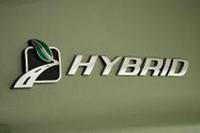A Guide to ... Hybrid Cars
SEE ALSO: Electric Vehicles Now Being Served SEE ALSO: EV-MOTORING.COM
We are witnessing what the industry calls the gradual electrification of the motor car.
That is, petrol engines are going to get smaller and electric motors will get bigger as battery technology and public recharge points improve ... Until, eventually, the petrol engine can disappear from some city cars altogether.
The first stepping stone on this path is the hybrid car. For those who aren't familiar with how they work it's simpler than all the tech talk makes it out to be.
For starters they don't need to be plugged in to electricity and, for the time being at least, they are fueled and serviced just like a normal car. If you opened the bonnet on today's hybrid car you'd see a petrol engine under the bonnet and an electric motor next to it.
In essence they are called hybrids because they merge two sources of power: petrol and electricity.
In the most popular example of the technology, the Toyota Prius, the electric motor can move the car from rest up to, say, about 40km/h and then the petrol engine automatically cuts in and takes over at cruising speeds.
The electric motor is powered by an onboard battery pack which is automatically recharged when the car coasts downhill or when the brakes are applied. No external electricity necessary. Pretty clever.
Typically you can get up to 800km or even 900km between refills. But there are as many critics of hybrid cars as there are fans. The downsides are that, for now, they're relatively expensive to buy.
And on a dollar per kilometre basis they don't make purely financial sense once you take into account the significant price premium for the car.
But, without the lessons learned from hybrid cars - and the people prepared to pay a premium for them - we wouldn't be as advanced on battery and electric motor technology as we are today.
The Toyota Prius passed the 1 million milestone in 2008 after 10 years of sales - and the efficiency of the electric motor and battery technology has improved with each new model.
We will continue to see hybrid versions of more cars, including in two years, the humble Camry.
This will occur as we inch towards the next stepping stone: plug-in hybrids. Plug-in hybrids are the same as regular hybrids but they have the ability to be recharged for a few hours to provide a longer petrol-free driving range.
For example, if you drove a standard Prius in Eco mode and turned the air-conditioning off and the road was flat and you had no traffic lights, you may get one or two kilometres before the petrol engine would kick in.
However, when driving normally, you typically get a few hundred metres of petrol free driving depending on how hard you push the accelerator.
But, with a plug-in hybrid, you could get, say, up to 20km of petrol-free driving. For a lot of people this is enough to get them to work and back without using a drop of petrol.
Plug-in hybrids are still a few years away from showrooms, but the technology is relatively straightforward as it effectively relies on larger battery capacity.
When full electric vehicles go on sale in the next few years, this will focus the emissions debate on how electricity is created.
Contrary to perception, cars are not the biggest polluters. According to data compiled by the Federal Government, the national fleet of passenger cars emits about 8 per cent of Australia's greenhouse gas emissions, coal fired power stations account for 50 per cent of Australia's greenhouse gas emissions.
About NRMA Insurance
NRMA Insurance<http://www.nrma.com.au/insurance.shtml> is a provider of insurance products, including car insurance<http://www.nrma.com.au/car-insurance/index.shtml> and home insurance<http://www.nrma.com.au/home-insurance/index.shtml> in NSW, ACT & TAS.



